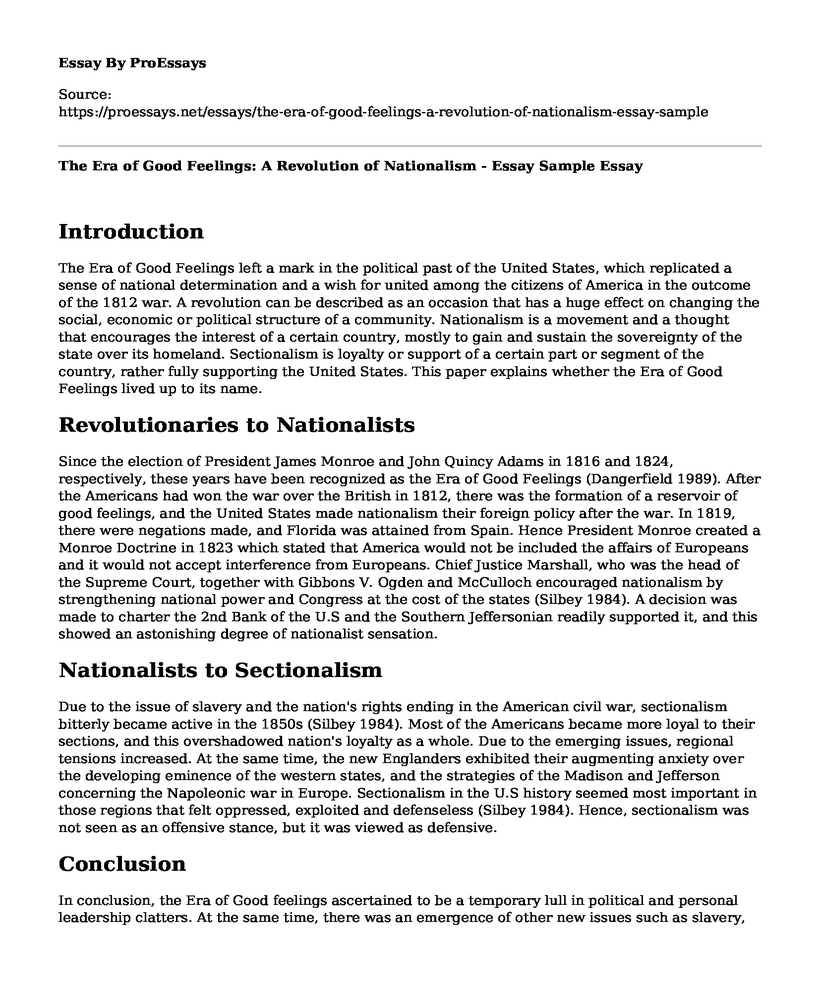Introduction
The Era of Good Feelings left a mark in the political past of the United States, which replicated a sense of national determination and a wish for united among the citizens of America in the outcome of the 1812 war. A revolution can be described as an occasion that has a huge effect on changing the social, economic or political structure of a community. Nationalism is a movement and a thought that encourages the interest of a certain country, mostly to gain and sustain the sovereignty of the state over its homeland. Sectionalism is loyalty or support of a certain part or segment of the country, rather fully supporting the United States. This paper explains whether the Era of Good Feelings lived up to its name.
Revolutionaries to Nationalists
Since the election of President James Monroe and John Quincy Adams in 1816 and 1824, respectively, these years have been recognized as the Era of Good Feelings (Dangerfield 1989). After the Americans had won the war over the British in 1812, there was the formation of a reservoir of good feelings, and the United States made nationalism their foreign policy after the war. In 1819, there were negations made, and Florida was attained from Spain. Hence President Monroe created a Monroe Doctrine in 1823 which stated that America would not be included the affairs of Europeans and it would not accept interference from Europeans. Chief Justice Marshall, who was the head of the Supreme Court, together with Gibbons V. Ogden and McCulloch encouraged nationalism by strengthening national power and Congress at the cost of the states (Silbey 1984). A decision was made to charter the 2nd Bank of the U.S and the Southern Jeffersonian readily supported it, and this showed an astonishing degree of nationalist sensation.
Nationalists to Sectionalism
Due to the issue of slavery and the nation's rights ending in the American civil war, sectionalism bitterly became active in the 1850s (Silbey 1984). Most of the Americans became more loyal to their sections, and this overshadowed nation's loyalty as a whole. Due to the emerging issues, regional tensions increased. At the same time, the new Englanders exhibited their augmenting anxiety over the developing eminence of the western states, and the strategies of the Madison and Jefferson concerning the Napoleonic war in Europe. Sectionalism in the U.S history seemed most important in those regions that felt oppressed, exploited and defenseless (Silbey 1984). Hence, sectionalism was not seen as an offensive stance, but it was viewed as defensive.
Conclusion
In conclusion, the Era of Good feelings ascertained to be a temporary lull in political and personal leadership clatters. At the same time, there was an emergence of other new issues such as slavery, and the northern was opposing slavery while the south wanted slaves to work in their farms.
Works Cited
Dangerfield, George. The era of good feelings. Vol. 110. Ivan R Dee, 1989.
Silbey, Joel H. "The Incomplete World of American Politics, 1815-1829: Presidents, Parties and Politics in “The Era of Good Feelings”." Congress & the Presidency: A Journal of Capital Studies. Vol. 11. No. 1. Taylor & Francis Group, 1984.
Cite this page
The Era of Good Feelings: A Revolution of Nationalism - Essay Sample. (2023, Aug 01). Retrieved from https://proessays.net/essays/the-era-of-good-feelings-a-revolution-of-nationalism-essay-sample
If you are the original author of this essay and no longer wish to have it published on the ProEssays website, please click below to request its removal:
- Historical and Contemporary Conception of Labor Strike
- Paper Example on Supporting Illegal Immigrants in the US
- Argumentative Essay on Liberal Education in the Current Society
- Analyzing Elements of Demagoguery in Kim Jong Un's New Year Speech Essay
- Essay Example on Thomas Jefferson's 1800 Presidential Campaign
- Essay Sample on Mercy's Steps for Accepting New Policy: Research, Testing, Feedback
- Essay Example on Egypt Uprising Aftermath: Protests Over Gov't Failure to Protect Minorities







